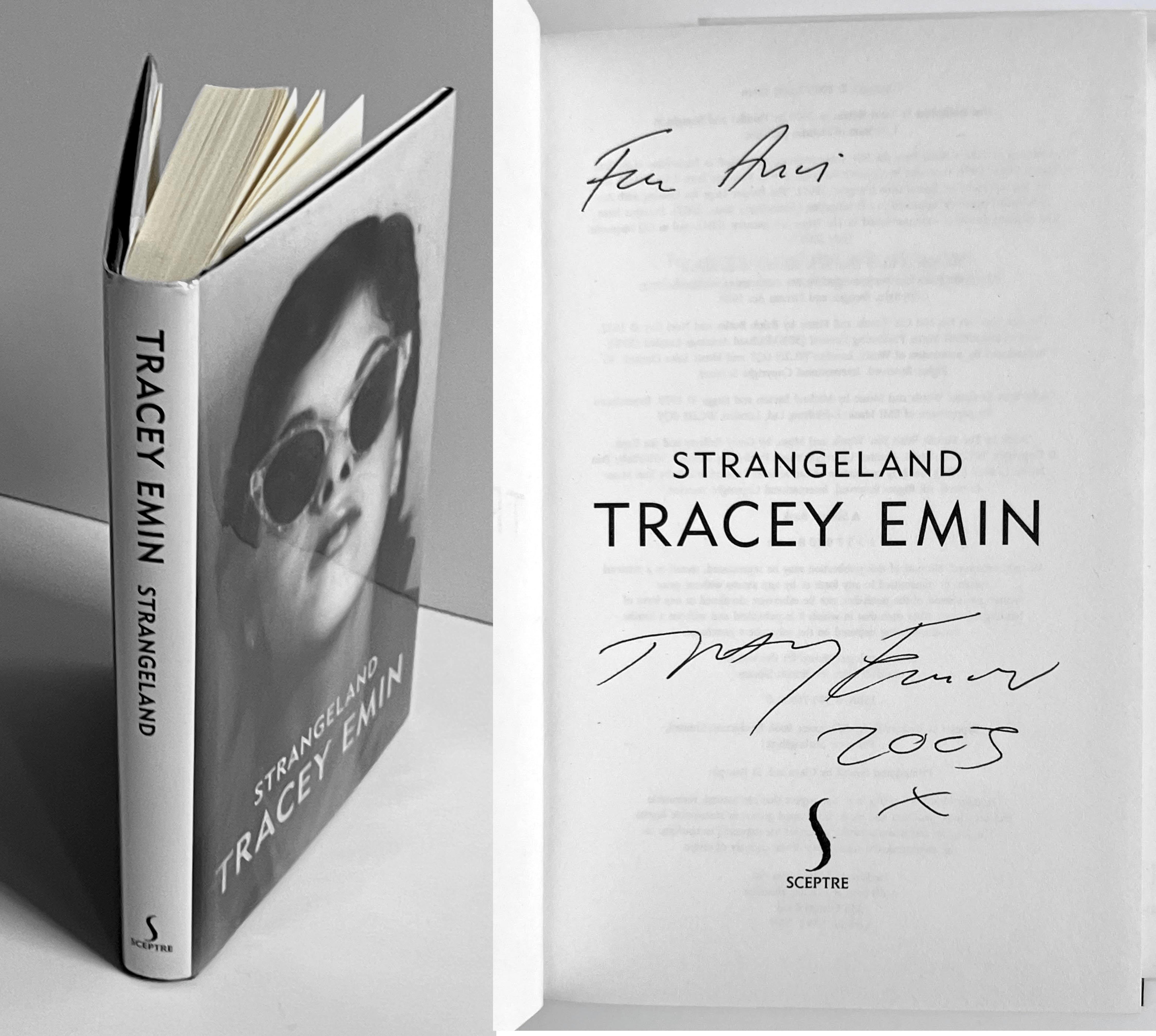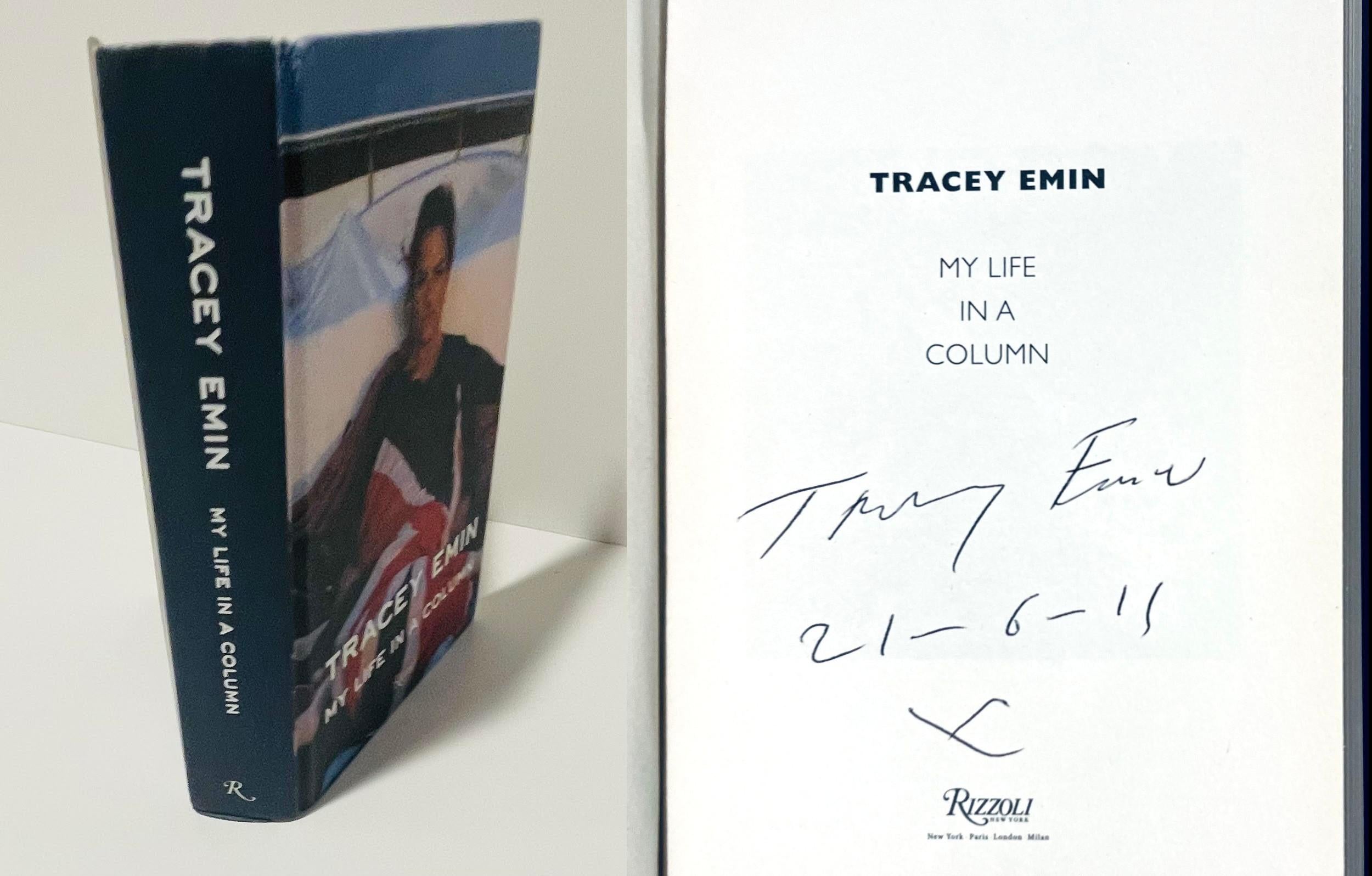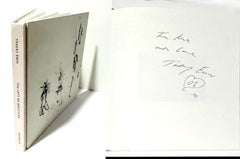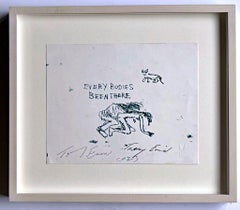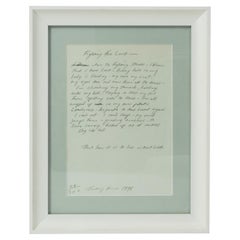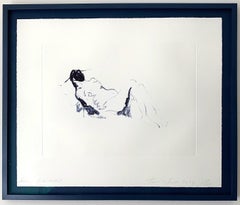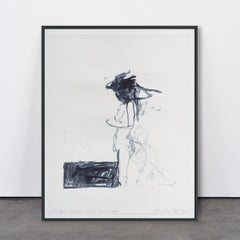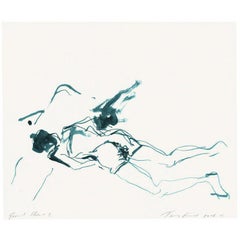Items Similar to Do Not Abandon Me (Hand signed in green marker by Tracey Emin)
Want more images or videos?
Request additional images or videos from the seller
1 of 19
Louise Bourgeois & Tracey EminDo Not Abandon Me (Hand signed in green marker by Tracey Emin)2010
2010
$2,500
£1,874.49
€2,173.20
CA$3,488.88
A$3,896.76
CHF 2,024.88
MX$47,454.72
NOK 25,720.45
SEK 24,236.08
DKK 16,214.69
Shipping
Retrieving quote...The 1stDibs Promise:
Authenticity Guarantee,
Money-Back Guarantee,
24-Hour Cancellation
About the Item
Louise Bourgeois & Tracey Emin
Do Not Abandon Me (Hand signed in green marker on the half title page by Tracey Emin), 2010
Cloth hardback monograph with no dust jacket as issued (Hand signed in green marker on the half title page by Tracey Emin)
Limited Edition of 1500 (this is exceptionally hand signed; the regular edition is unsigned)
Hand signed in green marker on the half title page by Tracey Emin
14 1/4 × 12 1/4 × 1/2 inches
This elegant, highly collectible limited edition monograph with cloth boards and no dust jacket, as issued, was published in a stated limited edition of 1500 (the regular edition was unsigned) to accompany the exhibition "Louise Bourgeois and Tracey Emin Do Not Abandon Me" by Carolina Nitsch, NY, September 10 to October 23, 2010 and Hauser & Wirth, London, February 18 to March 22, 2011.
Hand signed in green marker on the half title page by Tracey Emin.
Makes a superb gift!
Book information:
Publisher: Hauser & Wirth Publishers / Carolina Nitsch (September 2010)
English; Clothbound hardcover; 42 pages with color illustrations
Publisher's blurb:
Do Not Abandon Me', a collaboration between Louise Bourgeois and Tracey Emin, consists of sixteen intimate works made between 2008 and 2010.
About Tracey Emin:
Self-portraiture and the nude run throughout her practice, which Emin has described as being about ‘rites of passage, of time and age, and the simple realisation that we are always alone’. Her earliest works refer to her family, childhood and chaotic teenage years, growing up in the seaside town of Margate and leaving home at the age of fifteen. What happened next is explored, in a manner that is neither tragic nor sentimental, in drawing, painting, film, photography, sewn appliqué, sculpture, neon and writing, as the vicissitudes of relationships, pregnancies and abortions intersect with her commitment to the formal disciplines of art. Most recently, the artist has experienced her body as a battleground, through illness and ageing, on which she reports with characteristic fearlessness.
The playful title of Emin’s first solo exhibition, My Major Retrospective 1963–1993, suggests the artist felt, despite being at the beginning of her career, significant things had already happened. Her obsessive assemblage of personal memorabilia included tiny photographs of her art school paintings that she’d destroyed, a ‘photographic graveyard’ that revealed an admiration for paintings by Egon Schiele and Edvard Munch. She details this ‘emotional suiside’ in Tracey Emin’s CV Cunt Vernacular (1997), among several early video works that give further insight into her formation as an artist, highlighting moments of epiphany through the use of first-person narrative. ‘I realised there was the essence of creativity, that moment of conception,’ she says in How It Feels (1996), a pivotal film in which she tells the story of her abortion. ‘The whole being of everything… it had to be about where it was really coming from’. Speaking to camera while walking through the streets of London, she concludes that conceptual art, as an act of reproduction, is inseparable from the artist’s inner life. Developing this connection, the haunting film Homage to Edvard Munch and All My Dead Children (1998) shows the artist on the pier near Munch’s house, naked and prostrate in the foetal position, the dawn rising over the water as she lifts her head and screams – a guttural response to great painter’s iconic image.
In 1998, Emin created My Bed, an uncensored presentation of her most personal habitat. The double bed has become abstracted from function as it sits on the gallery floor, in conversation with art history and a stage for life events: birth, sleep, sex, depression, illness, death. The accumulation of real objects (slippers, condoms, cigarettes, empty bottles, underwear) on and around the unmade bed builds a portrait of the artist with bracing matter-of-factness, defying convention to exhibit what most people would keep private. The work gained international attention as part of the Turner Prize, entering Emin into public consciousness. Another work that became a byword for her art of disclosure was the sculpture Everyone I Have Ever Slept With 1963−1995 (1995, destroyed 2004), where the names of all those she had ever shared a bed with – friends, lovers and family – were sewn on the inside of a tent, a crawl-space that invites the viewer to reflect on their own inventory.
Explicitly feminist, and acknowledging the influence of her friend and collaborator Louise Bourgeois, Emin’s choice of medium is integral to the story she tells. In hand-embroidered blankets and quilts, traditionally associated with women’s work, she pierces the visual field with words, combining scraps of different material with uneven stitching to spell out statements whose syntax and spelling remain uncorrected. With titles such as Mad Tracey from Margate. Everyone’s been there, (1997) or Helter Fucking Skelter (2001), they register the artist’s acute sensitivity to the views of those around her and give a riposte, just as the medium is a riposte to the classification of fine art, for centuries dominated by male artists. As she herself became newsworthy, both nationally and internationally, Emin used the publicity to prick other forms of decorum in the professional art world – such as never over-explaining. In longer form, her memoir, Strangeland (2005) offers an account of her journey to becoming ‘a fucked, crazy, anorexic-alcoholic-childless, beautiful woman. I never dreamt it would be like this.’ The text is riddled with spelling mistakes that challenge the form and carry through a sense of unfiltered process, as was also the case with her long-running newspaper column for The Independent (2005–09), in which she narrated her weekly goings-on under the title ‘My Life in a Column’.
Emin’s ongoing series of neons features snatches of text in her recognisable slanted handwriting, elevating fleeting thoughts and feelings as aphorisms: You touch my Soul (2020), I Longed For you (2019) or I don’t Believe in Love but I believe in you (2012). Her formulation of statements in the second person has the effect of placing the viewer squarely in the situation, and can encapsulate an entire romance in a pithy phrase, as in I want my time with You (2018), a twenty-metre-wide neon that greets passengers at London’s St Pancras Station. A critical part of her practice since the 1990s, the neons evoke the seafront lights of Margate, latent with the sense of dusk and faded glamour. Her birthplace is an abiding subject; it resurfaces in large-scale sculptures, where reclaimed wood and found materials are assembled in jagged structures that allude to the beach, pier, huts and tide markers. Margate’s famous theme park ‘Dreamland’ is referred to in several works, among them Self-Portrait (2001), which recreates the pleasure ground’s helter-skelter, and It’s Not the Way I want to Die (2005), which recalls the undulating roller-coaster in rickety, worn wood, fragile to the point of collapse. Margate is ‘part of me’, Emin says, and while looking back she is now looking to the future with the establishment of TKE Studios, a new art school and artists’ studios.
Questions of mortality and the centrality of the female reproductive body drive The Mother (2021), one of Emin’s most significant public sculptures. Permanently sited next to the new Munch Museum, Oslo, it marks the death of her own mother, and brings her lifelong admiration for Munch full circle. Fifteen tonnes of bronze standing nine metres high, this woman with ‘her legs open to the Fjord’ is visible from afar over land and water, a monument to the female figure as protector without compromising on her vulnerability or eroticism. By contrast, Baby Things, Emin’s accurate rendering of children’s tiny lost shoes and clothes in bronze, was installed as if by chance outside the British Pavilion at the Venice Biennale (2007) and around Folkestone Triennial (2008), intimate tokens that might inadvertently provoke a range of reactions, from fear for those we love most, to the indifference with which we treat a discarded object.
Most recently, Emin’s work has been charged by the seriousness of her medical situation, since in 2020 she was diagnosed with bladder cancer. Self-portraits taken on her camera phone in bed find the artist facing her ‘crippling’ insomnia in the small hours, and in recovery from extensive surgery. Her paintings of the nude figure have a tempestuous energy. Emin’s graphic line, by turn delicate or vigorous, imparts a sense of urgency; with each abandoned and assertive gesture, she is flaying herself open. Drips and obliterations point to the fluidity of the body, as it fluctuates between joy and suffering on its journey between birth and death. Explosions of colour allude to a self that is overcome by feeling and triumphing in sheer sensuality.
Tracey Emin was born in 1963 in London. She currently lives and works between London, the South of France, and Margate, UK. Emin has exhibited extensively including major exhibitions at Royal Academy of Arts, London (2020); Musée d’Orsay, Paris (2019); Château La Coste, Aix-en-Provence, France (2017); Leopold Museum, Vienna (2015); Museum of Contemporary Art, Miami (2013); Museo de Arte Latinoamericano de Buenos Aires (2012); Turner Contemporary, Margate, UK (2012); Hayward Gallery, London (2011); Kunstmuseum Bern (2009); Scottish National Gallery of Modern Art, Edinburgh (2008); Centro de Arte Contemporáneo, Malaga, Spain (2008); Art Gallery of New South Wales, Sydney (2003); and Stedelijk Museum, Amsterdam (2002).
In 2007 Emin represented Great Britain at the 52nd Venice Biennale and her installation My Bed has been included in ‘In Focus’ displays at Tate Britain with Francis Bacon (2015), Tate Liverpool with William Blake and also at Turner Contemporary, Margate alongside JMW Turner (2017). In 2011, Emin was appointed Professor of Drawing at the Royal Academy of Arts, London, and in 2012 was made Commander of the Most Excellent Order of the British Empire for her contributions to the visual arts.
Courtesy of White Cube
About Louise Bourgeois:
Born in France in 1911, and working in America from 1938 until her death in 2010, Louise Bourgeois is recognized as one of the most important and influential artists of the 20th Century. For over seven decades, Bourgeois’s creative process was fueled by an introspective reality, often rooted in cathartic re-visitations of early childhood trauma and frank examinations of female sexuality. Articulated by recurrent motifs (including body parts, houses and spiders), personal symbolism and psychological release, the conceptual and stylistic complexity of Bourgeois’s oeuvre—employing a variety of genres, media and materials—plays upon the powers of association, memory, fantasy, and fear.
Bourgeois’s work is inextricably entwined with her life and experiences: fathoming the depths of emotion and psychology across two- and three-dimensional planes of expression. ‘Art,’ as she once remarked in an interview, ‘is the experience, the re-experience of a trauma.’ Arising from distinct and highly individualized processes of conceptualization, Bourgeois's multiplicity of forms and materials enact a perpetual play: at once embedding and conjuring emotions, only to dispel and disperse their psychological grasp. Employing motifs, dramatic colors, dense skeins of thread, and vast variety of media, Bourgeois's distinctive symbolic code enmeshes the complexities of the human experience and individual introspection.
Rather than pursuing formalist concerns for their own sake, Bourgeois endeavored to find the most appropriate means of expressing her ideas and emotions, combining a wide range of materials—variously, fabric, plaster, latex, marble and bronze—with an endless repertoire of found objects. Although her oeuvre traverses the realms of painting, drawing, printmaking, and performance, Bourgeois remains best known for her work in sculpture.
Bourgeois’s early works include her distinct 'Personages' from the late 1940s and early 1950s; a series of free-standing sculptures which reference the human figure and various urban structures, including skyscrapers. The ‘Personages’ served as physical surrogates for the friends and family Bourgeois had left behind in France, while also highlighting an interest in architecture dating back to her childhood. Her installation of these sculptures as clustered ‘environments’ in 1949 and 1950 foreshadowed the immersive encounters of installation art twenty years before the genre’s rise to prominence.
Bourgeois’s work was included in the seminal exhibition ‘Eccentric Abstraction,’ curated by Lucy Lippard for New York's Fischbach Gallery in 1966. Major breakthroughs on the international scene followed with The Museum of Modern Art in New York's 1982 retrospective of her work; Bourgeois's participation in Documenta IX in 1992; and her representation of the United States at the 45th Venice Biennale in 1993.
In 2001, Bourgeois was the first artist commissioned to fill the Tate Modern’s cavernous Turbine Hall. The Tate Modern’s 2007 retrospective of her works, which subsequently traveled to the Centre Pompidou in Paris; The Guggenheim Museum in New York; The Museum of Contemporary Art in Los Angeles; and The Hirshhorn Museum & Sculpture Garden in Washington D.C., cemented her legacy as a foremost grande dame of late Modernism.
- Courtesy of Hauser & Wirth
- Creator:Louise Bourgeois & Tracey Emin
- Creation Year:2010
- Dimensions:Height: 14.25 in (36.2 cm)Width: 12.25 in (31.12 cm)Depth: 0.5 in (1.27 cm)
- Medium:
- Movement & Style:
- Period:
- Condition:
- Gallery Location:New York, NY
- Reference Number:1stDibs: LU1745213546192
About the Seller
5.0
Platinum Seller
Premium sellers with a 4.7+ rating and 24-hour response times
Established in 2007
1stDibs seller since 2022
440 sales on 1stDibs
Typical response time: 2 hours
- ShippingRetrieving quote...Shipping from: New York, NY
- Return Policy
Authenticity Guarantee
In the unlikely event there’s an issue with an item’s authenticity, contact us within 1 year for a full refund. DetailsMoney-Back Guarantee
If your item is not as described, is damaged in transit, or does not arrive, contact us within 7 days for a full refund. Details24-Hour Cancellation
You have a 24-hour grace period in which to reconsider your purchase, with no questions asked.Vetted Professional Sellers
Our world-class sellers must adhere to strict standards for service and quality, maintaining the integrity of our listings.Price-Match Guarantee
If you find that a seller listed the same item for a lower price elsewhere, we’ll match it.Trusted Global Delivery
Our best-in-class carrier network provides specialized shipping options worldwide, including custom delivery.More From This Seller
View AllTracey Emin: I Lay Here For You (Hand signed and dated fine art monograph)
By Tracey Emin
Located in New York, NY
Tracey Emin: I Lay Here For You (Hand signed and dated book), 2022
Hardback monograph (hand signed and dated by Tracey Emin) on Munken Lynx Smooth Natural White 170 gsm with endpapers of Colorplan Candy Pink 135 gsm; matt laminate printed cover with black head and tail bands
Hand signed and dated by Tracey Emin on the title page.
9 × 6 3/4 × 2/5 inches
Unframed
Hardback monograph with illustrated boards and no dust jacket as issued, hand signed by Tracey Emin.
A beautifully designed publication I Lay Here For You, sumptuously illustrated and with a fascinating essay by Katy Hessell, author of The History of Art without Men.
About the project:
Tracey Emin’s first Scottish show since 2008, I Lay Here For You (28 May – 2 October) will offer an intimate encounter with love and hope set against the domestic architecture and informal woodland of Jupiter Artland. Imbued with connotations of both warmth and vulnerability, resonating with Tracey Emin’s belief of the ‘personal as political’ the exhibition will feature brand new work by the artist reflecting on the possibility of love after hardship.
Tracey Emin’s participation in Jupiter Artland’s 2022 season begins with the unveiling I Lay Here For You, a six metre bronze sited personally by the artist in an old-growth beech grove. Larger than life, powerful and at ease, the sculpture presents a radically different view of woman’s place...
Category
2010s Pop Art Figurative Prints
Materials
Ink, Mixed Media, Offset
Monograph: You Left Me Breathing (Hand signed and inscribed by Tracey Emin)
By Tracey Emin
Located in New York, NY
Tracey Emin
You Left Me Breathing (Hand signed and inscribed with a hand drawn heart flourish by Tracey Emin), 2008
Hardback monograph with no dust jacket as issued (Hand signed and ...
Category
Early 2000s Pop Art More Art
Materials
Paper, Ink, Mixed Media, Lithograph, Offset
Monograph: Strangeland (Hand signed, dated and inscribed by Tracey Emin)
By Tracey Emin
Located in New York, NY
Tracey Emin
Strangeland (Hand signed, dated and inscribed by Tracey Emin), 2005
Hardback monograph with dust jacket (hand signed, dated and inscribed for Ann by Tracey Emin)
Hand sig...
Category
Early 2000s Pop Art Figurative Prints
Materials
Paper, Ink, Mixed Media, Lithograph, Offset
Every Bodies Been There (Signed twice with both printed AND rare hand signature)
By Tracey Emin
Located in New York, NY
Tracey Emin
Every Bodies Been There (signed twice), 1998
Lithograph on paper
Underneath that existing plate signature, Tracey Emin has, exceptionally hand signed and dated the work f...
Category
1990s Contemporary Figurative Prints
Materials
Lithograph
One Thousand Drawings By Tracey Emin (Hand signed and inscribed book for Nadine)
By Tracey Emin
Located in New York, NY
Tracey Emin
One Thousand Drawings By Tracey Emin (Hand signed and inscribed for Nadine), 2009
Hardback monograph with dust jacket (ink signed and inscribed by Tracey Emin)
Hand signed, dated and inscribed to Nadine by Tracey Emin
7 × 10 × 2 1/2 inches
This is the First Edition of the hardback monograph with dust jacket "One Thousand Drawings" by Tracey Emin - featuring reproductions of 1000 of her drawings. It was hand signed, dated and inscribed in ink to the current owner - our gallery director - at the 2011 Marc Jacobs pop up bookstore in Manhattan. (see attached article for details)
Inscription reads:
For Nadine
Love Tracey Emin
2011
NY
X
Publisher's Blurb:
Tracey Emin has stirred controversy as well as acclaim since she rose to fame as the most highly publicized of the infamous Young British Artists. Though denounced by conservative critics at the outset, Emin’s work has attracted serious critical attention since the early 1990s for being consistently engaging, original, and startlingly direct. Her work has succeeded over the years in many media—from films to appliqués, embroideries, and installations—but it is in her works on paper that the honesty and frankness that have come to characterize her work are most fully realized. Edited by the artist herself from an archive of work stretching back before the beginnings of her career in the late 1980s, A Thousand Drawings is at once a collection of Emin’s works on paper, an exposé of her life as an artist, and a collectible artifact in itself. Many of these works on paper shed light on well-known multimedia pieces, previously studied in Works 1963–2006, published by Rizzoli in 2006. Stripped of the distractions of form and context, her bare and enigmatic drawings are presented on bible-thin paper in a uniquely beautiful slipcased volume, with an introduction by the artist. From considered self-portraits to pen-and-ink drawings and informal studies on lined notebook paper, this remarkable collection is as much a catalogue of Emin’s preoccupations as it is a monument to her raw and evocative talents as an artist.
Review
“Emin-an artist who is not afraid to wear her heart on her sleeve, or, indeed too embroider it on a blanket-personally chose the pictures for this book, and the delicate sketches are at once a glimpse of the profundity she’s capable of, and a reminder of vulnerability.” ~Nylon Magazine
About the Author
Tracey Emin was born in London in 1963. Nominated for the Turner Prize in 1999 and chosen to represent Britain at the 52nd Venice Biennale in 2007, Emin is also a member of the Royal Academy of Arts. The author of several books, including Strangeland, her memoir, she contributes regularly to The Independent newspaper and lives and works in London.
Publisher : Rizzoli; First Edition (July 28, 2009)
Language : English
Hardcover : 2016 pages
Provenance:
Personally inscribed to the present owner (our gallery director) at Bookmarc, NY, a pop up art...
Category
Early 2000s Pop Art Abstract Prints
Materials
Ink, Mixed Media, Lithograph, Offset
Monograph: My Life in a Column (book hand signed and dated by Tracey Emin)
By Tracey Emin
Located in New York, NY
Tracey Emin
My Life in a Column (hand signed and dated by Tracey Emin), 2011
Hardback monograph with dust jacket (hand signed and dated on the title page)
hand signed and dated 21-6-...
Category
2010s Contemporary More Art
Materials
Paper, Ink, Mixed Media, Lithograph, Offset, Board
You May Also Like
Fighting for Love, Tracey Emin, Offset lithograph, 1998
By Tracey Emin 1
Located in Seattle, WA
Fighting for Love by Tracey Emin, circa 1998. Offset lithograph on pale green paper, signed, numbered (29/300), and framed. Measures 11.75 x 8.25 inches.
Originally purchased from Wh...
Category
1990s Modern Contemporary Art
Materials
Paper
Further Back to You
By Tracey Emin
Located in London, GB
Tracey Emin
Further Back To You, 2014
Polymer Gravure on 300 gsm Somerset Paper
Signed, numbered and dated by the artist
framed in ink blue frame.
42 × 50.8 cm
Edition of 150
publish...
Category
2010s Contemporary Nude Prints
Materials
Paper, Lithograph
The Best Conversation I ever had – Laughter, (from A Journey to Death) - Emin
By Tracey Emin
Located in Zug, CH
The Best Conversation I ever had – Laughter, (from A Journey To Death), 2021
Colour lithographs on Somerset Velvet Warm White 400gsm
Signed, numbered, and dated by the artist
In mint...
Category
2010s Young British Artists (YBA) Figurative Prints
Materials
Lithograph
Tracey Emin, Grand Hotel I, Lithograph Print, 2016
By Tracey Emin
Located in London, GB
Tracey Emin, Grand Hotel I, Lithograph Print, 2016
A Polymer gravure lithograph printed on Somerset 300gsm paper
From a limited edition of 100.
81/100
Hand signed, titled and numb...
Category
21st Century and Contemporary Feminist Prints and Multiples
Materials
Paper, Lithograph, Polymer
I Am The Last Of My Kind
By Tracey Emin
Located in London, GB
Published by the Royal Academy
Category
2010s Contemporary Figurative Prints
Materials
Lithograph, Offset
I Am The Last Of My Kind
By Tracey Emin
Located in London, GB
Published by the Royal Academy
Category
2010s Contemporary Figurative Prints
Materials
Lithograph, Offset


